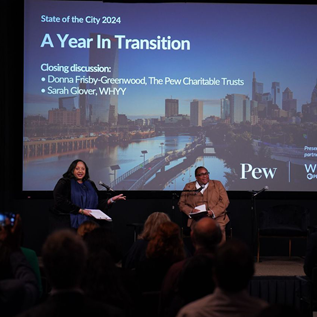Fostering the Future: Safety, Permanence and Well-Being for Children in Foster Care
Foster care protects children who are not safe in their own homes. For some children, it is literally life-saving. But for too many children, what should be a short-term refuge becomes a longterm saga, involving multiple moves from one foster home to another. None of us would want this for our own children.
Children in foster care cannot count on things that all children should be able to take for granted—that they have constant, loving parents; that their home will always be their home; that their brothers and sisters will always be near; and that their neighborhoods and schools are familiar places. Some children in foster care don't understand why they were removed from their birth parents and blame themselves. Most don't know whether or when they will rejoin their parents or become part of a new, permanent family.
Childhood should not be this way. Yet on any given day in the United States, half a million children and youth are in foster care, removed from their homes because of abuse or neglect. Almost half of these children spend at least two years in care, waiting for the safe, permanent family that should be their birthright. Almost 20 percent wait five or more years.1 In fiscal year (FY) 2001, nearly 39,000 infants under the age of one entered foster care,2 where they may lack the stability that promotes attachment and early brain development. That same year, about 19,000 older youth “aged out” of foster care without a permanent family to support them in the transition to adulthood.3
On average, children have three different foster care placements.4 Frequent moves in and out of the homes of strangers can be profoundly unsettling for children, particularly when they do not know how long they will stay and where they will go next. One young man told us that, as a child growing up in foster care, he checked every day to see if his belongings had been packed in anticipation of another move.
This kind of turbulence and uncertainty in childhood can have lasting consequences. Children who spend many years in multiple foster homes are substantially more likely than other children to face emotional, behavioral, and academic challenges. As adults, they are more likely to experience homelessness, unemployment, and other problems.5 While some of these problems likely have their roots in the underlying abuse or neglect that led a child into foster care in the first place, long and uncertain periods in foster care also contribute to these poor outcomes.6
When children languish in foster care, caseloads rise to untenable levels, and even the most dedicated case workers cannot provide the attention and support that children need. Case workers burn out and leave the profession in very high numbers. The annual turnover rate in the child welfare workforce is 20 percent for public agencies and 40 percent for private agencies.7 As the cadre of experienced case workers shrinks, the quality of care that children receive diminishes as well.
The shortage of licensed family foster homes further exacerbates the situation. Case workers scramble to find appropriate placements, often to little avail. Adolescents, in particular, can end up in group homes or institutions that offer few of the advantages of a family, while posing much higher costs to states and the federal government. A shortage of treatment options for parents, particularly substance abuse treatment and mental health services, also contributes to children staying longer in foster care.
The problem of children languishing in foster care is hardly new. But most of the time, it is a quiet crisis, below the radar of most citizens – until a child in foster care dies, or is abused, or is lost and cannot be accounted for. Even then, discussions of how to respond can quickly bog down in the intricacies of the system and the complexities of the families involved. Where, for example, would reform begin? With workforce improvements and lower caseloads? More and better substance abuse treatment? Less crowded court dockets? Or all of the above, all at the same time?
This seemingly endless list of urgent problems confronted the Pew Commission on Children in Foster Care when we began our work in May 2003. Indeed, we might have directed our efforts to any of these problems. Instead, we focused on reform of two key issues that underlie many of the problems in child welfare today: a federal financing structure that encourages an overreliance on placement of children in foster care, and a court system that lacks sufficient tools, information, and accountability necessary to move children swiftly out of foster care and into permanent homes. Reform in these two areas is a critical first step to solving many other problems that plague the child welfare system.
We began our work by developing a set of guiding principles that articulate what we want for children in the child welfare system. We then considered various policy options in light of these principles. The principles were an important touchstone throughout our year of deliberations, focusing us consistently on the children at the heart of the child welfare system.
Our work built on a solid base of federal statutes that emphasize safety for children and support for families. These laws also establish the shared responsibility of the federal government, the states, and the courts to protect abused and neglected children and secure safe, permanent homes for them. The nation's first significant child welfare legislation, the Adoption Assistance and Child Welfare Act of 19808 set forth the twin goals of preserving families and securing permanence for children, and it gave new responsibilities to the courts for overseeing child welfare cases. Subsequent legislation in 19939 and 199410 provided new funding for prevention of child abuse and neglect, family preservation, and court improvements. The Adoption and Safe Families Act (ASFA) of 199711 established the goals of safety, permanence, and well-being for children in foster care, with a very deliberate emphasis on permanence. This bipartisan legislation also focused attention on measuring states' performance toward national goals and further increased the role of the courts in overseeing child welfare cases.
These landmark pieces of legislation reflected lawmakers' concern over growing numbers of children in foster care and the long periods of time that so many children stayed in care. These laws and others have made important and lasting improvements in the ability of child welfare agencies and the courts to meet the needs of children who have been abused and neglected. But more remains to be done. The number of children in foster care appears to be stabilizing, but at a very high level. There were 534,000 children in foster care in 2002, almost double the number in care in the early 1980s.12 Moreover, children continue to stay in foster care for longer periods than may be necessary, and to move frequently from placement to placement. While in care, many children still do not receive appropriate services, whether they are infants suffering the effects of trauma or older adolescents about to leave foster care to live on their own. Interwoven with all of these challenges is the over-representation of minority children in foster care—especially African-American children, who enter foster care at the fastest rate and leave at the slowest.
The Pew Commission's recommendations identify “next steps” on the road to reducing the number of children in foster care, shortening the amount of time children have to spend there, and responding better to the needs of all children in care. The steps we recommend are in the direction of reforming federal financing of child welfare service and court oversight of child welfare cases, for reasons we discuss below.









